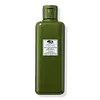innisfree Youth Enhancing Treatment Essence with Black Tea + Peptides Versus Origins Dr. Andrew Weil Mega-Mushroom Soothing Treatment Lotion
What's inside
What's inside
 Key Ingredients
Key Ingredients

 Benefits
Benefits

 Concerns
Concerns

No concerns
 Ingredients Side-by-side
Ingredients Side-by-side

Camellia Sinensis Leaf Water 95%
MaskingWater
Skin ConditioningPropanediol
SolventGlycerin
HumectantNiacinamide
Smoothing1,2-Hexanediol
Skin ConditioningCamellia Sinensis Leaf Extract
AntimicrobialEthylhexylglycerin
Skin ConditioningAdenosine
Skin ConditioningDextrin
AbsorbentEctoin
Skin ConditioningHyaluronic Acid
Humectant3-O-Ethyl Ascorbic Acid
Skin ConditioningGlutathione
Mannitol
HumectantSaccharomyces Cerevisiae Extract
Skin ConditioningButylene Glycol
HumectantCentella Asiatica Flower/Leaf/Stem Extract
Skin ConditioningGlycine Max Polypeptide
Skin ConditioningArginine/Lysine Polypeptide
Skin ConditioningCopper Tripeptide-1
Skin ConditioningDisodium EDTA
Acetyl Tetrapeptide-11
Skin ConditioningCaprylyl Glycol
EmollientAcetyl Heptapeptide-4
HumectantSorbic Acid
PreservativeHexapeptide-9
Skin ConditioningAcetyl Hexapeptide-8
HumectantSodium Hydroxide
BufferingAcetyl Octapeptide-3
HumectantCamellia Sinensis Leaf Water 95%, Water, Propanediol, Glycerin, Niacinamide, 1,2-Hexanediol, Camellia Sinensis Leaf Extract, Ethylhexylglycerin, Adenosine, Dextrin, Ectoin, Hyaluronic Acid, 3-O-Ethyl Ascorbic Acid, Glutathione, Mannitol, Saccharomyces Cerevisiae Extract, Butylene Glycol, Centella Asiatica Flower/Leaf/Stem Extract, Glycine Max Polypeptide, Arginine/Lysine Polypeptide, Copper Tripeptide-1, Disodium EDTA, Acetyl Tetrapeptide-11, Caprylyl Glycol, Acetyl Heptapeptide-4, Sorbic Acid, Hexapeptide-9, Acetyl Hexapeptide-8, Sodium Hydroxide, Acetyl Octapeptide-3
Water
Skin ConditioningButylene Glycol
HumectantSaccharomyces Ferment Filtrate
HumectantGlycerin
HumectantHypnea Musciformis Extract
Skin ProtectingCitrus Nobilis Peel Oil
MaskingBoswellia Carterii Oil
MaskingLavandula Angustifolia Oil
MaskingPogostemon Cablin Leaf Oil
MaskingCitrus Aurantium Dulcis Oil
MaskingPelargonium Graveolens Flower Oil
MaskingLimonene
PerfumingCitronellol
PerfumingLinalool
PerfumingGeraniol
PerfumingGanoderma Lucidum Extract
Skin ProtectingPhellinus Linteus Extract
Skin ConditioningGelidiella Acerosa Extract
Skin ProtectingFuscoporia Obliqua Sclerotium Extract
Skin ConditioningHippophae Rhamnoides Extract
MaskingLactobacillus Ferment
Skin ConditioningSodium Hyaluronate
HumectantSucrose
HumectantSalicylic Acid
MaskingCaffeine
Skin ConditioningGlycine Soja Seed Extract
Skin ConditioningDipotassium Glycyrrhizate
HumectantGlycereth-26
HumectantCaprylyl Glycol
EmollientPEG-40 Hydrogenated Castor Oil
EmulsifyingTrideceth-9
EmulsifyingPolysorbate 20
EmulsifyingGlucosamine Hcl
Citric Acid
BufferingSodium Hydroxide
BufferingSodium Citrate
BufferingSorbic Acid
PreservativePotassium Sorbate
PreservativePhenoxyethanol
PreservativeWater, Butylene Glycol, Saccharomyces Ferment Filtrate, Glycerin, Hypnea Musciformis Extract, Citrus Nobilis Peel Oil, Boswellia Carterii Oil, Lavandula Angustifolia Oil, Pogostemon Cablin Leaf Oil, Citrus Aurantium Dulcis Oil, Pelargonium Graveolens Flower Oil, Limonene, Citronellol, Linalool, Geraniol, Ganoderma Lucidum Extract, Phellinus Linteus Extract, Gelidiella Acerosa Extract, Fuscoporia Obliqua Sclerotium Extract, Hippophae Rhamnoides Extract, Lactobacillus Ferment, Sodium Hyaluronate, Sucrose, Salicylic Acid, Caffeine, Glycine Soja Seed Extract, Dipotassium Glycyrrhizate, Glycereth-26, Caprylyl Glycol, PEG-40 Hydrogenated Castor Oil, Trideceth-9, Polysorbate 20, Glucosamine Hcl, Citric Acid, Sodium Hydroxide, Sodium Citrate, Sorbic Acid, Potassium Sorbate, Phenoxyethanol
 Reviews
Reviews

Ingredients Explained
These ingredients are found in both products.
Ingredients higher up in an ingredient list are typically present in a larger amount.
Butylene Glycol (or BG) is used within cosmetic products for a few different reasons:
Overall, Butylene Glycol is a safe and well-rounded ingredient that works well with other ingredients.
Though this ingredient works well with most skin types, some people with sensitive skin may experience a reaction such as allergic rashes, closed comedones, or itchiness.
Learn more about Butylene GlycolCaprylyl Glycol is a humectant and emollient, meaning it attracts and preserves moisture.
It is a common ingredient in many products, especially those designed to hydrate skin. The primary benefits are retaining moisture, skin softening, and promoting a healthy skin barrier.
Though Caprylyl Glycol is an alcohol derived from fatty acids, it is not the kind that can dry out skin.
This ingredient is also used as a preservative to extend the life of products. It has slight antimicrobial properties.
Learn more about Caprylyl GlycolGlycerin is already naturally found in your skin. It helps moisturize and protect your skin.
A study from 2016 found glycerin to be more effective as a humectant than AHAs and hyaluronic acid.
As a humectant, it helps the skin stay hydrated by pulling moisture to your skin. The low molecular weight of glycerin allows it to pull moisture into the deeper layers of your skin.
Hydrated skin improves your skin barrier; Your skin barrier helps protect against irritants and bacteria.
Glycerin has also been found to have antimicrobial and antiviral properties. Due to these properties, glycerin is often used in wound and burn treatments.
In cosmetics, glycerin is usually derived from plants such as soybean or palm. However, it can also be sourced from animals, such as tallow or animal fat.
This ingredient is organic, colorless, odorless, and non-toxic.
Glycerin is the name for this ingredient in American English. British English uses Glycerol/Glycerine.
Learn more about GlycerinSodium Hydroxide is also known as lye or caustic soda. It is used to adjust the pH of products; many ingredients require a specific pH to be effective.
In small amounts, sodium hydroxide is considered safe to use. However, large amounts may cause chemical burns due to its high alkaline.
Your skin has a natural pH and acid mantle. This acid mantle helps prevent harmful bacteria from breaking through. The acid mantle also helps keep your skin hydrated.
"Alkaline" refers to a high pH level. A low pH level would be considered acidic.
Learn more about Sodium HydroxideSorbic Acid is a preservative. It is the most commonly used food preservative in the world.
Sorbic Acid is a natural antibiotic and highly effective at preventing the growth of fungus. It is less effective against bacteria.
Potassium Sorbate, another commonly-used preservative, is the potassium salt of Sorbic Acid.
Sorbic Acid may worsen eczema. We recommend speaking with a professional if you have any concerns.
Potassium sorbate and sorbic acid can be found in baked goods, cheeses, dried meats, dried fruit, ice cream, pickles, wine, yogurt, and more.
Learn more about Sorbic AcidWater. It's the most common cosmetic ingredient of all. You'll usually see it at the top of ingredient lists, meaning that it makes up the largest part of the product.
So why is it so popular? Water most often acts as a solvent - this means that it helps dissolve other ingredients into the formulation.
You'll also recognize water as that liquid we all need to stay alive. If you see this, drink a glass of water. Stay hydrated!
Learn more about Water